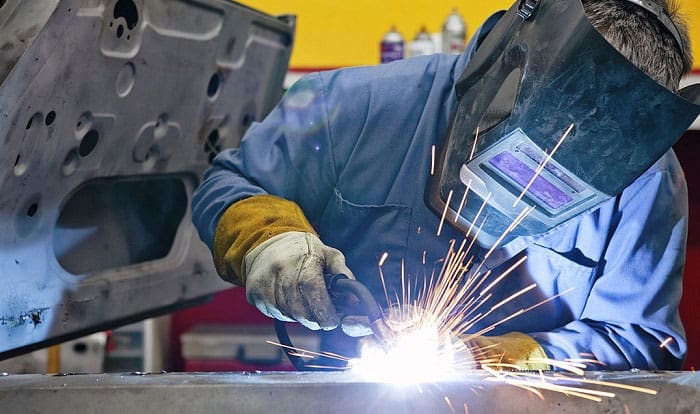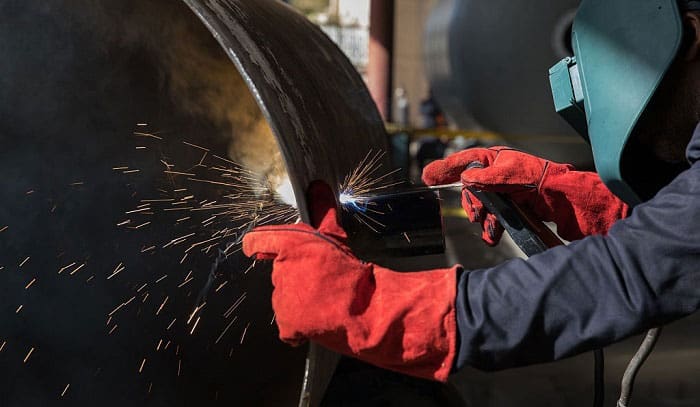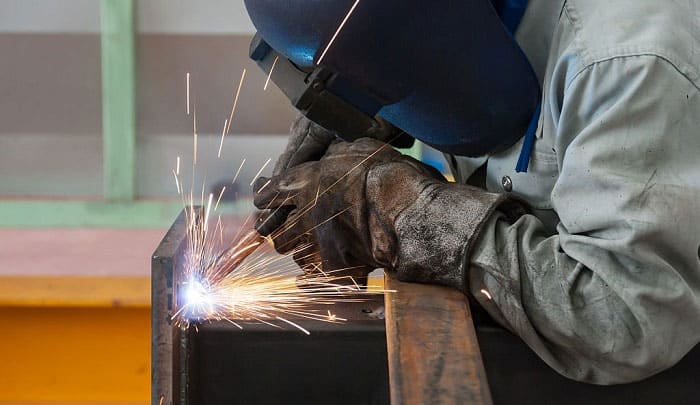Welding is fascinating work yet hazardous at the same time since you have to closely contact with high-temperature heat for a long time. Therefore, it is essential that you are well-equipped with protection equipment.
Besides some basic equipment such as helmets and coveralls, welding safety gloves are important parts of a welding ensemble. Wearing the right pair of welding gloves will do wonders by increasing your productivity, comfort, and most of all, safety.
Furthermore, what are welding gloves made of? Well, there are different kinds of welding gloves made for different purposes. Therefore, choosing which welding gloves material depends on what you are welding.
In general, they are made from a combination of or one of these three types of leather: cowhide, pig skin, or goat skin. Other kinds of leather might also be used in the production of welding gloves.
However, before coming to that part, let’s go over what I’m going to talk about in this article:
- Why Do We Need Welding Gloves? For safety reasons, welding gloves will protect you from injuries caused by high heat, electric shock, and flames during the welding process.
- Are There Any Requirements for Welding Gloves? Yes, there are several welding hand gloves specifications such as moisture resistance, heat and electrical insulation, etc.
- Different Types of Welding Gloves: Three primary welding gloves are TIG, stick, and MIG welding gloves.
- Materials that Welding Gloves are Made of: Some possible types of leather that can be used to manufacture welding gloves are cowhide, pigskin, deerskin, and goatskin.
Are you prepared to learn more about welding gloves? Continue reading to find out!
Table of Contents
Why Do We Need Welding Gloves?
Welders face numerous dangers while working that even a moment of distraction may take away their lives. Lacking hand protection, welders might get electrically shocked, hand burnt, or other injuries to a mild or serious degree.
Additionally, other injuries mean having their hands smashed by a machine or accidentally cut by a sharp tool in the factory. During the welding process, there are probably sparks, hot flying dust, grease, grime, or very tiny and uncontrollable chemicals.
If the welders have those objects contacted on their bare skin, there is a high likelihood that their skin will be burnt. This is the reason why welding gloves use is a must while working in this industry since this will reduce the possibility of the workers being injured. In the following section, we will see what welding gloves standards are.
Are There Any Requirements for Welding Gloves?
Although it depends on the purpose of your using the welding gloves and which types you should use, knowing some basic requirements of welding gloves might be helpful. First thing first, insulation of heat is our top priority.
No matter which welding process you are working on, there will always be a certain amount of heat produced, which is why we need welding gloves instead of other ordinary types of gloves. Thus, make sure your welding gloves protect you from the high heat while working.
As you have your gloves to protect you from the outside heat, be sure that the gloves allow heat to be released from the inside. That is, your gloves should be able to keep your hands dry and cool.
Thirdly, electrical insulation is also something you should take into consideration. As I’ve mentioned above, welders are at risk of being electrically shocked without proper hand protection. Therefore, remember to ask for electrical-insulated pairs of welding gloves when considering the options.
Comfort and durability should be the essential features of your welding gloves as well. Try to imagine if you are able to wear those welding gloves for hours without taking them off continuously or not. Move your fingers to see if you face any problems as well.
Moreover, our welding gloves should be cut resistant to avoid you being cut when working with sharp and rough metal edges. Lastly, make sure that the shape or the material of the gloves won’t interfere with you while working.
Different Types of Welding Gloves
1. TIG Welding Gloves
These gloves are known for their dexterity, which is the ability to perform precise tasks with your hands. Thus, they are usually made of thin and pliable materials such as goatskins. As a result, you can expect these TIG gloves to be less protective from splattering and high heat than other gloves.
When putting these gloves on, try to pick up a coin to test their dexterity. If you can’t, finding another pair of welding gloves might be a better idea. Some TIG gloves also provide extra padding inside our palms to create more comfort for the users.
2. MIG Welding Gloves
Contrary to the TIG welding gloves, MIG welding gloves are more resistant to high heat and splattering. Thus, they have higher protection from harmful sparks, spatters, and heat. Nonetheless, these gloves will be slightly heavier than the TIG ones since they are usually made of top-grain cowhide, deerskin, or goatskin.
3. Stick Welding Gloves
The third category of welding gloves is stick welding, which requires a lot of extremely heavy duty. Consequently, people working on this kind of welding need the highest level of protection.
Thus, the gloves will be made of thicker cuts of cow split, elk skin, goat skin, or pig skin. Moreover, expect these gloves to be much less flexible than the other two due to their material.
Materials That Welding Gloves Are Made of
1. Cowhide
Cowhide is known for its excellent resistance against flame and heat for welding tasks requiring high temperature. Moreover, you can expect a high level of durability, dexterity, comfort, and abrasion resistance. Therefore, this is the material that is usually preferred by welders who want protection over a prolonged duration of time.
2. Elkskin
Among all materials that are used to manufacture welding gloves, elkskin is the most resistant to flame, abrasion, and heat that you can find. At the same time, it provides great comfort for those who wear it. In addition, elkskin has a reputation for its protection capability in stick welding thanks to the availability of heavier and thicker cuts.
3. Pigskin
Pigskin is quite thin, so it isn’t ideal for heat resistance. However, gloves from pigskin have better flexibility as well as weather and oil resistance.
4. Deerskin
One of the outstanding features of deerskin is its excellent dexterity and comfort for the users. Deerskin with thick cuts can provide great insulation against high temperature as well. Also, many people find it more comfortable using deerskin gloves over a long time as this material takes the form of your hands.
Conclusion
In the end, what are welding gloves made of? Generally speaking, the materials vary according to the functions and features of the gloves. They can be made from pigskin, cowhide, deerskin, or elkskin. While some of them are better in heat resistance, others have better advantages in dexterity, comfort, etc.
I hope this article provides you with useful information. Let me know which kinds of welding gloves work for you in the comment section. Share this article with your friends and family as well.

Veronica is our content editor. She is a talent in delivery. Her main work is editing and writing articles that are both informative and simple to follow. She is in charge of synthesizing our understanding of what personal protection equipment (PPE) is needed in each job, how to best apply it, and how to visualize that equipment.




